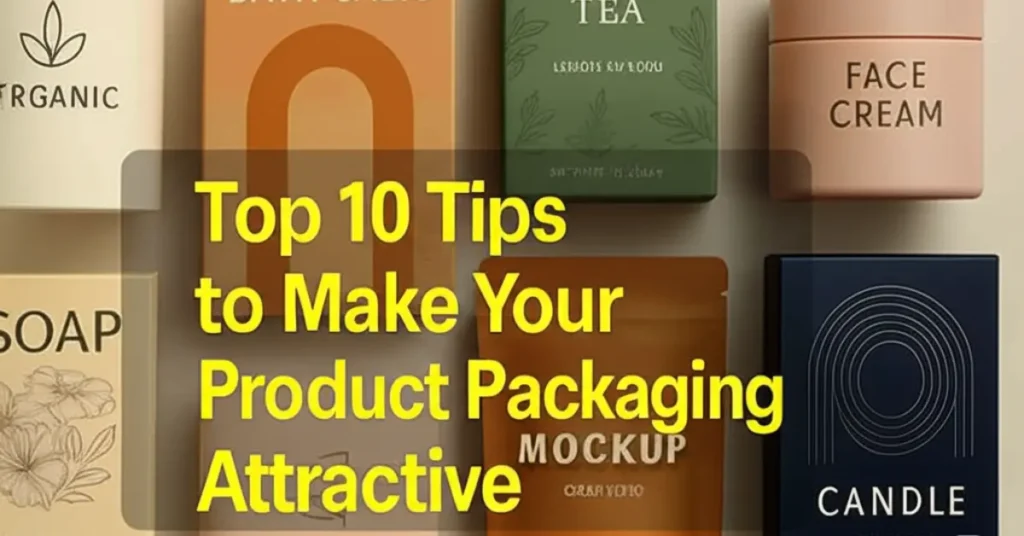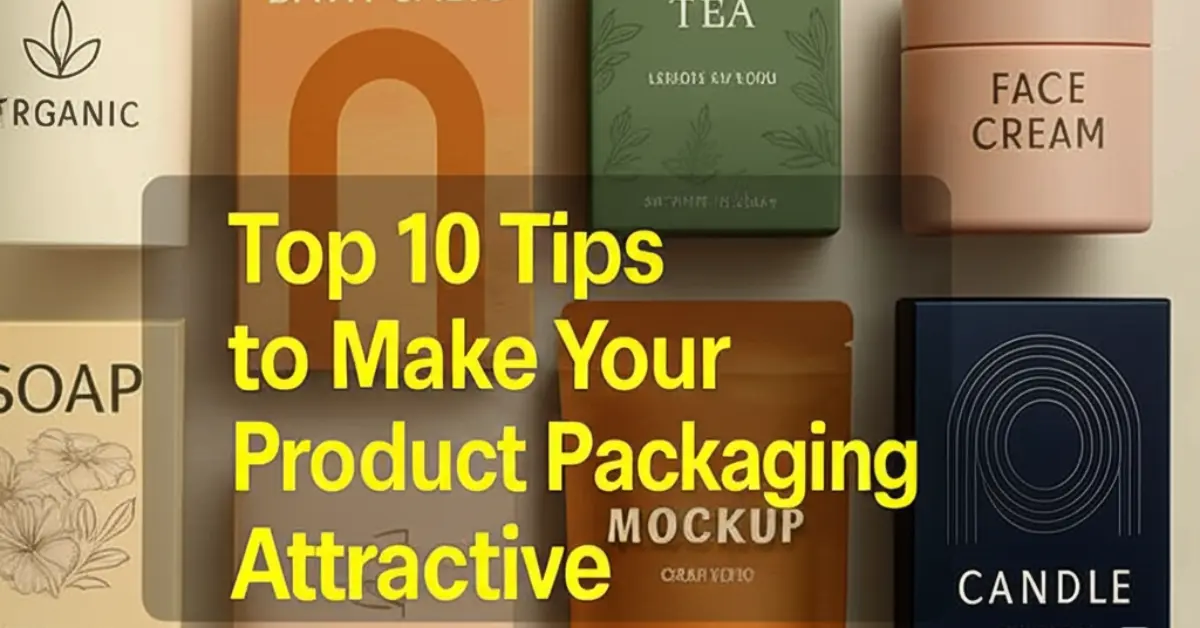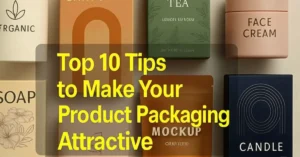Introduction
When a customer sees your product for the first time, the packaging speaks before they even read a word. It can make them curious, excited, or even ready to buy—without saying a thing.
Attractive packaging is about more than colors and logos. It’s about creating a look and feel that matches your brand and makes people want to pick it up, explore it, and remember it.
In this guide, we’ll share 10 practical tips you can use right away to make your packaging stand out on shelves and online. Each tip comes with examples and ideas to help you design something customers won’t forget.
Top 10 Tips to Make Your Product Packaging Attractive
I’ve studied 10 proven tips that can make your product packaging more attractive, boost your brand appeal, and improve customer experience. Here they are:
Tip #1 – Keep It Simple and Eye-Catching
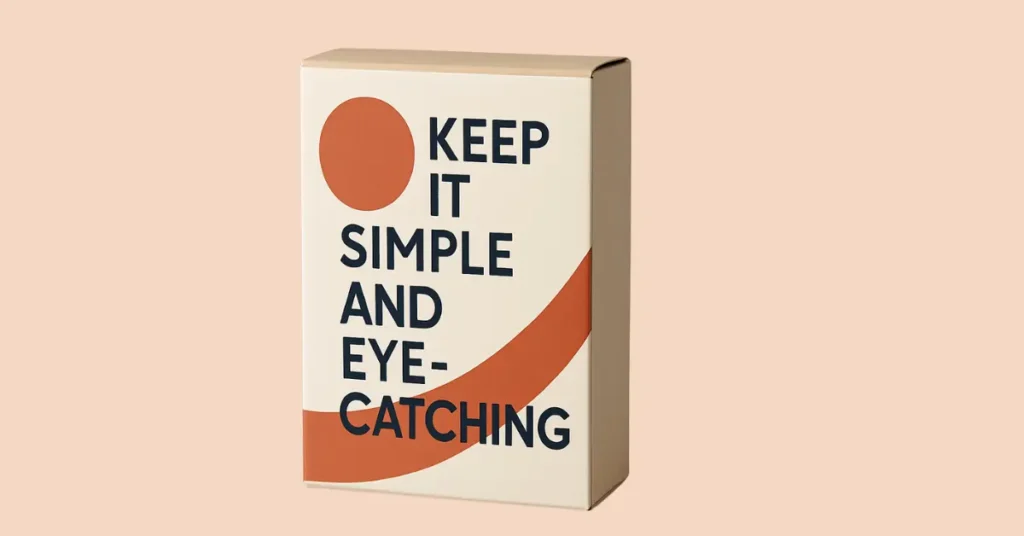
When it comes to packaging design, less is often more. A simple design doesn’t mean boring — it means clear, clean, and easy for customers to understand at first glance.
Think about it: when someone is shopping, your packaging has only a few seconds to grab their attention. If it’s too crowded with text, images, and colors, the buyer’s eyes may skip over it.
How to keep it simple yet attractive:
- Focus on one main visual element — like your logo or a product image.
- Use 2–3 colors only for a clean, professional look.
- Leave some empty space (white space) so your design can “breathe.”
- Use clear fonts that are easy to read even from a distance.
Example:
Brands like Apple and Glossier use minimal designs, neutral colors, and plenty of white space — making their packaging look premium and easy to recognize.
📌 Pro Tip:
If you’re not sure where to start, create a simple version of your design first, then slowly add elements until it feels just right.
Tip #2 – Use High-Quality Materials
First impressions aren’t just visual — they’re also tactile. Sturdy, premium materials instantly communicate care, reliability, and value. Cheap, flimsy packaging can undermine even the best product.
Why it matters:
High-quality materials protect your product during shipping, create a premium feel, and help customers trust your brand from the moment they touch the box.
How to get it right:
- Choose sturdy stock – For boxes, use thick corrugated or rigid board that resists crushing.
- Upgrade finishes – Lamination, embossing, or soft-touch coatings can elevate the look and feel.
- Eco-friendly options – Recycled or compostable materials can attract environmentally conscious buyers.
Examples:
- Apple – Uses rigid, perfectly fitted boxes with a smooth matte finish for a luxury feel.
- Tiffany & Co. – Their signature blue boxes are made from high-grade board that holds shape beautifully.
- Samsung – Uses solid, minimal packaging that protects electronics while feeling premium.
📌 Pro Tip:
Consider your target audience — if they value sustainability, premium and eco-friendly materials will give you a competitive edge.
Tip #3 – Use Colors That Match Your Brand
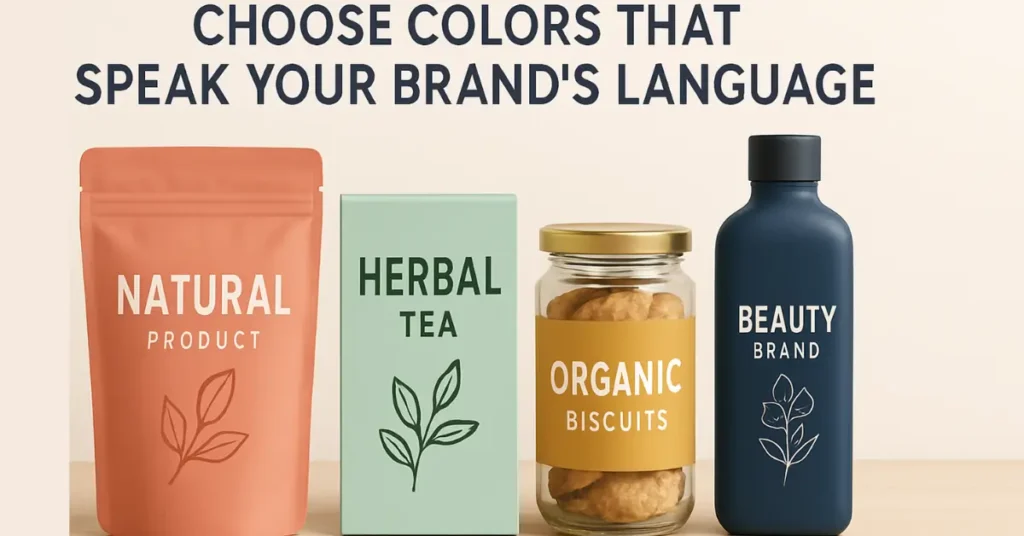
Colors aren’t just decoration — they tell your brand’s story before a single word is read. The right colors can make your packaging instantly recognizable and trigger emotions in your customers.
For example:
- Red can show excitement and energy.
- Blue feels trustworthy and calm.
- Green connects to nature and freshness.
How to choose the right colors:
- Match your brand personality — if your brand is fun and playful, choose bright, bold colors.
- Stay consistent — use the same colors on your boxes, website, and marketing so people remember you.
- Think about your audience — young customers may like vibrant colors, while luxury buyers prefer muted tones.
Example:
Coca-Cola’s red and white instantly stand out, while Tiffany & Co.’s signature blue box is unforgettable.
📌 Pro Tip:
Test your colors on both screen and printed packaging — sometimes they look very different in real life.
Tip #4 – Use Colors That Match Your Brand Personality
Colors aren’t just decoration — they tell your brand’s story without saying a word. The right color palette can instantly signal who you are and what you stand for.
Why it’s important:
Colors trigger emotions. Bright, bold shades can spark excitement, while soft, muted tones create elegance and trust.
How to get it right:
- Match your brand vibe — fun, energetic brands often use vibrant tones; luxury brands lean towards gold, black, or deep colors.
- Stay consistent — repeat the same colors across all packaging for instant recognition.
- Ensure readability — make sure text stands out clearly against the background.
Examples:
- McDonald’s – Red and yellow make people feel hungry, happy, and energetic.
- Tiffany & Co. – The iconic Tiffany blue is now a symbol of elegance and exclusivity.
- Apple – Clean white and silver packaging communicates minimalism and premium quality.
📌 Pro Tip:
Create a brand color guide so every product you release looks connected and recognizable.
Tip #5 – Add a Memorable Logo or Brand Mark
Your logo is like your brand’s signature — it tells customers, “This is from us, and it’s special.” A strong, well-placed logo can make your packaging instantly recognizable even from a distance.
Why it matters:
When customers see your logo repeatedly, they start associating it with quality, trust, and the feeling your brand gives them.
How to get it right:
- Keep it clear — your logo should be sharp and easy to read, even on small packages.
- Place it strategically — choose a spot where it’s visible the moment someone picks up the product.
- Make it part of the design — integrate your logo with patterns, colors, or textures for a seamless look.
Examples:
- Nike – The simple swoosh is powerful enough to stand alone without text.
- Starbucks – Their green siren logo is instantly recognized worldwide.
- Louis Vuitton – The LV monogram is both a design and a status symbol.
📌 Pro Tip:
Use your logo consistently on boxes, bags, labels, and even inside the packaging for a premium, cohesive feel.
Tip #6 – Choose Colors That Speak Your Brand’s Language
Colors are not just decoration — they’re emotional triggers. The right color palette can make your packaging stand out, convey your brand’s personality, and even influence buying decisions.
Why it matters:
People often decide whether they like a product within seconds, and color plays a huge role in that snap judgment.
How to get it right:
- Match your brand identity – If you’re playful, go bright and bold; if you’re luxury-focused, choose muted, elegant tones.
- Be consistent – Use the same colors across packaging, website, and marketing for instant recognition.
- Think about contrast – Make sure text, logo, and design elements are easy to see.
Examples:
- Coca-Cola – Their iconic red is instantly linked with energy and excitement.
- Tiffany & Co. – The “Tiffany Blue” box is as famous as their jewelry.
- McDonald’s – Red and yellow trigger hunger and happiness.
📌 Pro Tip:
Test different shades before finalizing — colors can look different in print than on a screen.
Tip #7 – Use High-Quality Materials for a Premium Feel
The moment a customer touches your packaging, they instantly judge its quality. Cheap, flimsy materials can make even the best product feel less valuable — while sturdy, well-finished materials instantly give a premium vibe.
Why it matters:
First impressions are not just visual; they’re tactile. A solid, smooth, or textured finish can elevate your brand’s perception.
How to get it right:
- Invest in durability – Strong materials protect your product and reflect reliability.
- Match material to product – Luxury items deserve thick, textured paper or rigid boxes; eco-friendly brands might opt for recycled kraft board.
- Don’t forget the finish – Matte, gloss, or soft-touch coatings can add that extra touch of class.
Examples:
- Apple – Their unboxing experience feels luxurious thanks to thick, smooth-touch packaging.
- Godiva Chocolates – Uses gold foil and rigid boxes to enhance the premium feel.
- Nike (special edition sneakers) – Limited releases often come in sturdy, collectible boxes.
📌 Pro Tip:
Even if your budget is tight, you can choose mid-range materials but enhance them with clever finishes.
Tip #8 – Make Your Packaging Practical and User-Friendly
Beautiful packaging is great, but if it’s frustrating to open or store, it can ruin the experience. Customers appreciate designs that are as functional as they are attractive.
Why it matters:
When packaging is easy to open, reseal, or reuse, it not only improves the customer experience but also increases the chances they’ll remember and talk about your brand.
How to get it right:
- Easy opening – Avoid excessive tape or tricky seals.
- Resealable designs – Especially for food, cosmetics, or products that aren’t used all at once.
- Stackable or space-saving – Make it easy for customers to store your product at home.
Examples:
- IKEA – Their flat-pack boxes save space for both shipping and storage.
- Pringles – The resealable tube keeps chips fresh and unbroken.
- LEGO – Packaging that can be opened easily without damaging the box for collectors.
📌 Pro Tip:
Conduct a quick “opening test” with a few people — if it’s not effortless, it’s time to rethink the design.
Tip #9 – Go Eco-Friendly Without Compromising Style
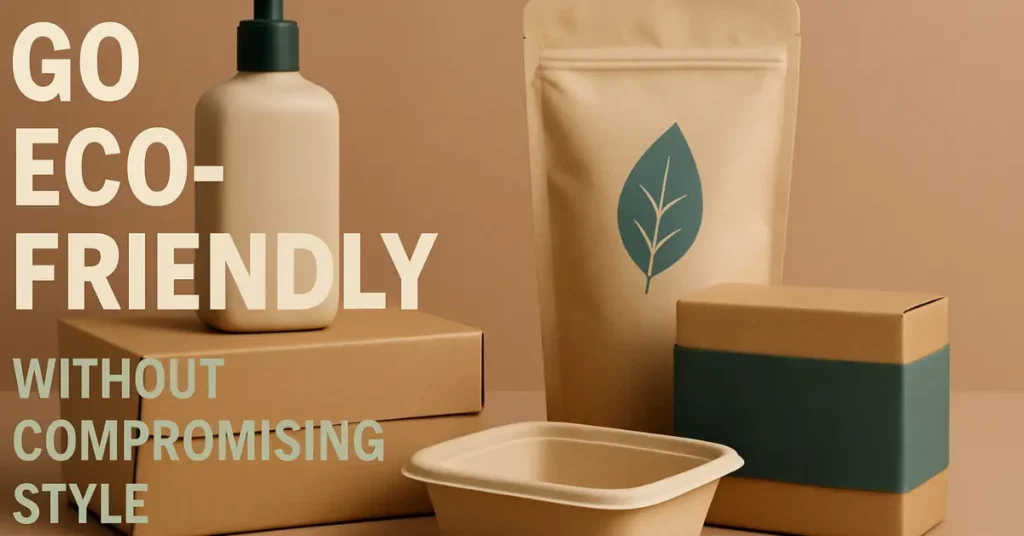
Today’s customers care about the planet — and they notice brands that do too. Eco-friendly packaging isn’t just a trend; it’s a statement about your values.
Why it matters:
Sustainable materials reduce environmental impact and appeal to eco-conscious buyers, making your brand more attractive and trustworthy.
How to get it right:
- Use recyclable or compostable materials – Cardboard, paper, or biodegradable plastics.
- Minimize waste – Avoid unnecessary layers or oversized boxes.
- Highlight your eco-efforts – Add a small message or icon to let customers know your packaging is sustainable.
Examples:
- Apple – Reduced plastic use in packaging by switching to fiber-based materials.
- Lush Cosmetics – Uses minimal or no packaging (“naked” products) to cut waste.
- Patagonia – Recycles and reuses packaging materials for shipping.
📌 Pro Tip:
Eco-friendly doesn’t mean boring — pair sustainable materials with great design to show style and responsibility in one.
Tip #10 – Make It Share-Worthy on Social Media
In the age of Instagram, TikTok, and YouTube unboxings, your packaging can be a powerful marketing tool — if it’s camera-ready.
Why it matters:
When customers share their unboxing experience online, it’s free advertising that reaches new audiences and builds brand credibility.
How to get it right:
- Focus on aesthetics – Use colors, textures, and layouts that pop on camera.
- Include surprise elements – A small gift, a hidden message, or unique tissue paper can spark delight.
- Encourage sharing – Add hashtags, QR codes, or a note inviting customers to post their experience.
Examples:
- Glossier – Known for their pastel pink pouches and Instagram-worthy presentation.
- Apple – Perfectly engineered unboxing that feels premium and satisfying.
- Nike – Special edition sneakers often come in creative, collectible boxes that fans showcase online.
📌 Pro Tip:
Treat your packaging like a stage — when it looks good under a smartphone camera, it works double duty as both protection and promotion.
Comparison Table – Different Packaging Styles for Attractiveness
| Packaging Style | Best For | Advantages | Drawbacks |
| Rigid Boxes | Luxury items, electronics, gifts | Premium look, sturdy, reusable | Higher cost |
| Corrugated Boxes | Shipping, bulk items | Durable, protective, cost-effective | Less premium |
| Folding Cartons | Retail products, cosmetics, food | Versatile, easy to print designs on | Not as strong |
| Kraft Paper Packaging | Eco-conscious brands, organic goods | Sustainable, rustic look, recyclable | Limited color range |
| Mailer Boxes | E-commerce, subscription boxes | Secure, branding-friendly | Slightly higher cost than poly mailers |
Pros & Cons of Investing in Attractive Packaging
| Pros | Cons |
| Builds strong first impressions | Can increase production cost |
| Boosts sales and brand loyalty | Requires design expertise |
| Encourages social media sharing | Requires market testing to ensure effectiveness |
| Differentiates from competitors |
Conclusion – Turn Your Packaging into a Brand Magnet
Attractive packaging isn’t just about wrapping your product — it’s about telling your brand’s story, creating excitement, and making customers feel special before they even see what’s inside. When you apply these 10 tips — from bold designs to social media-ready unboxing — you’re not just selling a product, you’re delivering an experience.
If you want packaging that wows your customers and boosts your brand image, Packaging Squad is here to help. We design and create custom packaging boxes that perfectly reflect your brand’s style and values. Whether you’re a small business or an established company, we make sure your packaging speaks volumes.
🚀 Ready to make your packaging unforgettable?
Get your custom packaging today and give your brand the first impression it deserves.
FAQs – Making Your Product Packaging Attractive
1. Why is attractive packaging important for my business?
Attractive packaging grabs attention, creates a strong first impression, and makes customers more likely to pick your product over competitors. It also communicates your brand’s quality and values without saying a word. You can explore our custom packaging solutions to see how the right design elevates your brand.
2. How can I make packaging look premium without spending too much?
Focus on simple but effective elements—minimalist design, quality typography, consistent brand colors, and neat finishing like matte or glossy lamination. For cost planning, our packaging price calculator helps you find the best material and style within your budget.
3. Does packaging design affect sales?
Yes. Studies show customers are more likely to try or repurchase a product if its packaging appeals to them visually and emotionally. Good design can also encourage sharing on social media, giving you free promotion.
4. How do I know if my packaging is working?
Track customer feedback, sales performance, and even unboxing reactions on social media. You can also run small-scale A/B tests to compare two packaging designs and see which one performs better.
5. Should I follow packaging trends or stick to my brand style?
Trends can be useful for inspiration, but your packaging should always reflect your brand identity. A timeless, consistent style often works better for long-term recognition than constantly chasing trends.
Final Thoughts
Your packaging is often the first—and sometimes only—chance to connect with your customer. By combining smart design, functional features, and brand personality, you can create packaging that not only protects your product but also turns it into a marketing tool.
At Packaging Squad, we help businesses design custom packaging boxes that are both attractive and practical. Whether you’re looking for eco-friendly packaging, luxury finishes, or budget-friendly options, our team can help you make the right choice. Start by trying our packaging price calculator to get an instant cost estimate.


